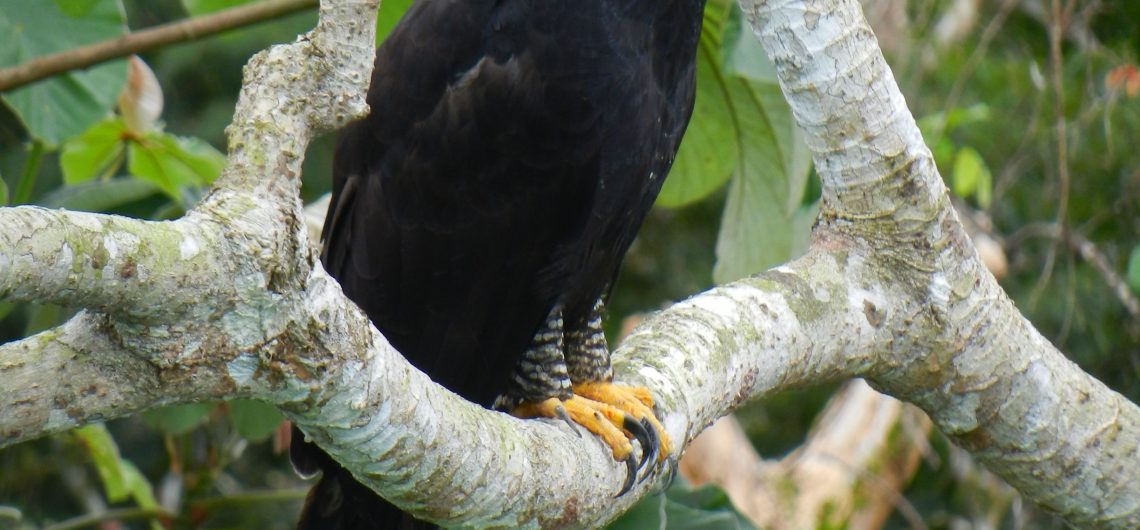
One of the great pleasures of anyone who has an appreciation for the natural world is watching an animal return back to its natural habitat. A sense of freedom and reunion with its community are instilled in both the animal and those involved in the release. From that point on, the animal must prove its skills to find food, shelter, a mate and use its instincts and learned behaviors to survive.
At the end of June, an adult Black Hawk-Eagle was confiscated by ANAM (Panama’s Ministry of the Environment) in Bocas Del Toro province of western Panama. Although in good condition, the eagle was brought to Summit Municipal Park near Gamboa to be monitored and to ensure it would be in a good state to be released into the forests of Soberanía National Park in central Panama.
By the end of August, the eagle was proving to show its strength and ability to catch and kill prey with its strong feet and sharp talons. Nestor Correa, director of Summit Municipal Park, and Ron Magill, visiting from Zoo Miami, decided it was time for this bird to be released. On the morning of Saturday, August 31, the bird was brought to the Canopy Tower to be released at canopy level from the Observation Deck, directly into the lowland forest of Soberanía National Park.
It was a beautiful morning, with blue sky and no rain or storm in sight. Just after 9:00 a.m., the release team made their way with a large kennel containing the eagle up to the top of the Canopy Tower. Canopy Tower staff, including guides Carlos Bethancourt and Michael Castro, were present for the release. The kennel was positioned on the platform, and the top was removed, exposing the eagle to the forest canopy. It hopped up on the edge of the kennel base, and looked around at its new surroundings. Once it got its bearings, it opened its broad wings and took its first flight into freedom and its new home. It landed in a tree in view, not too far from the top of the tower. It roused its feathers after its inaugural flight, and settled on a large branch.
To ensure ease into its new environment, Nestor provided food for the first couple days, consisting of a quail tied in a nearby tree. The next morning, the eagle was seen eating the quail. It seems to be adjusting well to being back in the wild, and these observations will hopefully ensure its long-term survival in the forests of central Panama.
The Black Hawk-Eagle, Spizaetus tyrannus, is a large, majestic bird of prey found in lowland forests of Central and South America from central Mexico south through the Amazon Basin, and in the Atlantic forests of Brazil and northern Argentina. It is 57–71 cm (22–28 in.) in length, and has a wingspan of 140 cm (4½ ft.). Black Hawk-Eagles are primarily black overall with black and white barring on their feathered legs. Their long tail shows three prominent bands of white, and the underside of their wings are heavily banded with white, which is evident in flight. Juveniles have a mottled beige-brown plumage. They often soar over the forest canopy and open areas. They are forest eagles —characterized by broad, paddle-shaped wings and long tails to maneuver through the understory. Like other hawk-eagles and forest eagles, they have a prominent crest. They frequently call while perched or soaring, a loud whistled call. Like all birds of prey, they have keen eyesight, powerful feet armed with sharp talons for catching prey, and a sharp, hooked beak for tearing meat. Black Hawk-Eagles, although smaller than other eagles, prey on relatively large prey including birds, arboreal mammals and reptiles. Monkeys, toucans, squirrels, bats, iguanas and snakes are known prey for Black Hawk-Eagles. This is the most frequently encountered species of hawk-eagle in Panama.
As this Black Hawk-Eagle starts its new life in the forests surrounding the Canopy Tower, it will soon begin to hunt on its own once again. We are eager to see if this bird stays in the vicinity of the Canopy Tower, and hope it adjusts well to its new home.
Updates…
September 10, 2013





